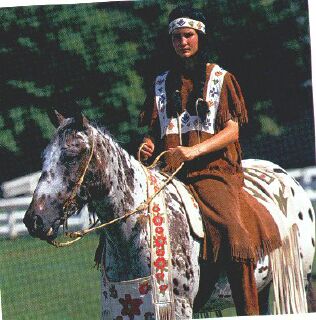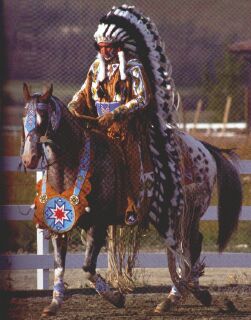HORSE OF THE NEZ PERCE'
 |
There are two stories about how the Appaloosa first came to live with the Nez Perce'. One tells of horses, descendants of the mustangs brought to the New World by the Spaniards, who arrived from the south. Among the horses traded to them by other tribes, these spotted creatures caught the eye of the Nez Perce' people and soon became the tribe's horse of choice. While this theory is the one most often cited by historians, there is another account, one handed down through the oral tradition of the tribes. It is a story of three stallions who came from the sea to the land. A ship from a faraway land we now know as Russia came to the shores of the Pacific Northwest. The stallions were sent from the ship to swim to the Nez Perce' traders, who received these amazing creatures with awe. These stallions had powerful medicine. When they were bred to the tribe's mares, this medicine was passed down to their young. Known as the Ghost Wind Stallions, these three horses are believed by some to be ancestors of the Appaloosa. |
 |
The story of the Nez Perce's flight from the U.S. cavalry has been told many times in history books. The tribe had lived for centuries in the Palouse Region of the Pacific Northwest. In 1877, the Nez Perce' entered a war with the U.S. government, and the entire tribe with all of its horses embarked on a journey that would take them 1,300 miles in three months toward the country of Canada, where they hoped to find refuge. Only a few miles before they reached the border of Canada, the tribe was besieged and outnumbered by the U.S. cavalry. Chief Joseph, their great leader, surrendered. There was sadness in his heart; sadness for the land he would never see again, sadness for the horses. Chief Joseph and his captured people were taken far away from their homeland, and the horses, those who had not escaped into the hills, were deliberately destroyed by army gunfire. Although the Nez Perce' were captured and taken to a reservation, their horses lost in the mountains or killed by soldiers, a few Appaloosas remained. Scattered around the West and recognizable by their unmistakable color and conformation, these horses still had advocates. Some whites continued to breed them quietly, seeking to preserve the same traits the Nez Perce' had so painstakingly developed. Just before the second World War began, a small group of these people came together to form the Appaloosa Horse Club, and they became the official caretakers of the breed. |
 |
As
much as the Nez Perce' loved their spotted companions, the tribe's enemies
feared them more. Wild and ferocious in battle, it was said the Nez Perce'
horse was trained to charge an enemy and knock him from his mount. The
horse would then attack the man, striking him with its hooves and tearing
at him with its teeth. But this same animal, said to be vicious on the
battlefield, would be cared for later that night by a young child whose
job it was to tend to the warriors' horses who had fought well in battle.
The Nez Perce' had a love of racing, and this is deeply etched into the Appaloosa's soul. Spotted horses were often pitted against one another, asked to challenge each other's swiftness over vast areas by the people who first bred them. The faster the horse, the more prized he was and the more he was bred, until the Appaloosa became a "ground-borne" Pegasus. Now, in our time, the Appaloosa continues to race against his brothers. On tracks around the country, spotted horses with winged feet strive to repeat the glory of their ancestors. But the greatest job of all for the Appaloosa horse is that of companion. Nez Perce' men grieved over their lost warhorses, while warhorses with fallen warriors went on to fight without them. Each horse shared his warrior's triumphs and defeats, in life and in war. The descendants of the Nez Perce' Appaloosas share this ability to bond with the people who love them most. In a calm, gentle way, these Appaloosas give their souls, quietly, subtly. And once the bond is forged, there is nothing that can destroy it--not even death. |
 |
While
there are hundreds of breeds the world over, there is only one horse whose
destiny placed her in the hands of a Native American people. While the color is
unique, so is the Appaloosa soul. She has been touched by a bond with a spiritual
people, a bond that no other breed has ever known. This horse is the Appaloosa.
The heart of the Appaloosa is that of a Native warhorse. Her devotion to the one who loves her is undying. The old ways, that ancient life in the wilderness are gone forever. The simplicity, the oneness with nature that was the Nez Perce' culture in its purest form can be no more. The memory of warriors on spotted mounts, of herds of thousands of Appaloosas grazing on the rich Palouse grasslands fades more with each passing day. But there is one remnant of this time in our country's history, one remaining piece of the past. It is not a museum object sitting under glass somewhere, or an artifact yet to be uncovered. It is a living, breathing creature whose genes share the substance of those horses of long ago and whose hearts bear the spirit of Chief Joseph's mighty herds. The Appaloosa horse, with all of her characteristics so important to those whose lives depended upon her, is a treasure--one that needs to be guarded and cherished for as long as we all are here. |
Excerpts and photos taken from the book "Appaloosa Spirit" Spirit of the Horse Series published by Bowtie Press